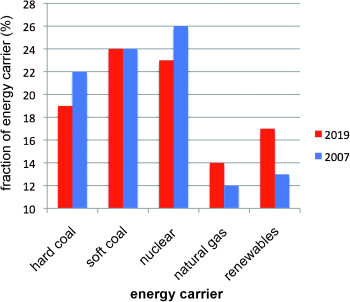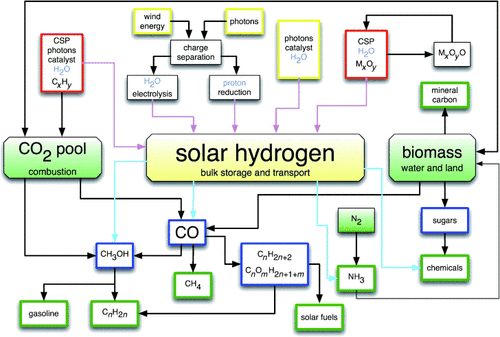Chemistry’s Role in Regenerative Energy
The call to replace nuclear energy with conventional and regenerative alternatives raises several issues relevant to the chemistry sciences. First, chemistry deals with the control of chemical reactions and thus forms the basis of energy conversion. While chemists are concerned mainly with the modification of molecular structures, engineers are interested in the energetic consequences of reactions, in this case the total oxidation of energy carriers. The control of chemical reactions involves manipulation of molecular energy barriers, and the laws of thermodynamics determine the possible uses of converted energy. Chemistry is thus central to discussions of effective and sustainable energy scenarios.

The large-scale use of regenerative energies to replace fossil energy carriers is not possible without chemical storage strategies. Unfortunately, catalysis as the science of mastering molecular energy barriers is not sufficiently well-developed to enable the rapid design of efficient energy storage processes from fundamental insight. Traditional empirical technology development will thus continue to coexist with the basic research that elucidates the underlying science. The fundamental science of chemical energy conversion should advanced simultaneously with the applied scientific and technological research offensive that is necessary to enable the use of non-nuclear and climate-neutral energy carriers.
The energy scenario for Germany illustrates the scales at which chemistry needs to contribute to the challenge. Fundamentally, it is clear that research efforts, even if they target incremental modifications, take a long time to become effective on the scale of national energy demand. Moreover, other economic and geographic regions of the world exhibit greatly different energy supply structures and thus require different strategies.
Multiple approaches are needed, and several parallel strategies for reducing the importance of nuclear and fossil energy carriers should be pursued. For the next few decades, we need successive generations of systemic approaches that operate in dynamic societal and economic boundary conditions. All suggestions must pass an early test of sustainability and scalability. Energy conversion and climate stability are two facets of the same systemic interdependence. The solution is not to replace nuclear risks by climate risks or to export local risks to other parts of the world. As it will be decades before new technologies are operational in relevant scales, it is imperative to start now with a large and diverse research program in both fundamental and applied sciences to provide the technology evolution and training opportunities for the large number of experts required.
In Figure 1 we see the mix of energy carriers used in Germany for electricity generation. About half of the primary energy comes still from coal, and the other half is dominated by nuclear energy. Even if the “old” (pre-1980) nuclear power plants would be removed from the mix, the large contribution from the “new” reactors cannot easily be replaced by any other energy carrier within the next decade as long as the target of massive reduction of greenhouse-gas emissions is maintained. It may be possible to retrofit old coal-fired power plants with modern high-efficiency combustion processes to replace some capacity of the old reactors. As the location of such plants may then be reconsidered in the light of the to-be-constructed “smart grid”, it may be wise to build new coal-fired power stations to produce more electricity at the same level of CO2 emission.

Energy carriers for generating electricity in Germany in 2008. The amounts given are normalized to the energy content in TWh. From http://www.bmwi.de/BMWi/Navigation/Energie/Statistik-und-Prognosen/energiedaten.html.
The combination of such activities with compulsory carbon capture and sequestration (CCS) strategies should be carefully considered, despite its superficial attractiveness. It is impossible to evaluate the benefit/risk ratio of transferring large amounts of CO2 into uncontrolled underground storage. Carbon dioxide is still reactive with respect to rock-formation processes, it does not decay, and it may induce unwanted consequences on a geological time frame. Using CO2 chemically in relevant quantities is a serious alternative once solar hydrogen is available, which is likely the target of highest priority for chemical energy science. The essential target of limiting greenhouse-gas emission can be achieved by reducing the amount of bioavailable carbon through carbon capture and use and through chemical transformation of biomass into mineral carbon. In the more distant future, the demand for transportable nonfossil energy carriers will require the large-scale conversion of carbon sources into molecular energy-storage systems using solar hydrogen. The dimensions of such a chemical synthesis effort may be estimated from the fact that about 30 % of imported primary energy in Germany is used for transportation. Sustainability requires not bequeathing risks to further generations by losing control over the fate of underground CO2.
Additional capacity for electricity generation must be provided by flexible systems that are capable of interacting favorably with the smart grid. These are gas-fired systems. The gas will initially be fossil-fuel natural gas but can over decades gradually be replaced by regenerative sources resulting from CO2 hydrogenation once water splitting is operational. This chemical energy-storage process need not only take place in the industrialized countries of the northern Hemisphere but could be one outlet of solar energy harvesting in regions rich in sunshine.
The desired increase of the share of existing regenerative energy sources in the energy mix in Figure 1 will, in the foreseeable future and even with installation of considerable additional capacity, only partly compensate nuclear energy, as mass storage of primary electricity is currently impossible. The smart grid will, however, increase the relevance of regenerative electricity production through better load management. Quantitative statements remain difficult to make, as a realistic system analysis involves many variables, and there is still a deficit of practical experience. This critical analysis must be performed by experts in close collaboration with the relevant sciences. The most critical variable will be how much additional CO2 emission is acceptable, which is a societal rather than a chemical issue.
The role of biomass as a storable and regenerative energy carrier is already substantial in the energy mix shown in Figure 1. Limited further increase may result from better use of wood and agricultural waste not only for electricity generation in large plants but also for local heating applications. More sophisticated uses of biomass include its chemical depolymerization and deoxygenation, which would render it an interesting chemical feedstock and potential replacement for mineral oil. Great care is needed not to stimulate excessive agricultural cultivation of energy crops in Germany or abroad at the expense of ecosystems and affordable food production.
A projection from the German power industry of the mix of energy carriers for electricity generation in 2018 (Figure 2 a) shows that even assuming substantial efforts towards change, the overall modification of the energy mix is slow on the grid scale. The decommissioning of old coal-fired power stations and of old nuclear plants drive increased use of natural gas and regenerative energy. The reduction of CO2 emissions that results from increased use of regenerative energy will be largely counteracted by the enhanced use of fossil energy carriers needed to compensate the reduced use of nuclear power. Assuming steady electricity consumption at current levels, a complete shutdown of all nuclear power plants in Germany by 2018 would lead to emission of additional 60–120 million tons of CO2 annually, depending on the fuel mix. Figure 2 illustrates the slow response and the enormous challenge associated with phasing out substantial amounts of nuclear or fossil energy carriers. The reduction of primary energy consumption is thus a very attractive target for research and technology.

Distribution of energy carriers for electricity generation in Germany. Red: projection for 2018 after a change in the composition of the energy mix; blue: data from 2008. From the German Association of Energy and Water Industries (Bundesverband der Energie- und Wasserwirtschaft, BDEW) 2011 and http://www.bmwi.de/BMWi/Navigation/Energie/Statistik-und-Prognosen/energiedaten.html.
Losses during energy conversion are the greatest single “use” of primary energy carriers, amounting to about 1300 TWh a−1 (2007), which may be seen in contrast to the total electricity production from nuclear reactors (160 TWh a−1 in 2007). Although many losses cannot be avoided, there are opportunities for process and materials chemistry to improve this wasteful situation. The task is a challenge not only for chemistry but to a large extent also for those disciplines that design and operate the complex network of energy-converting systems. But science alone cannot reduce energy consumption, and societal and economic insights and adaptations are crucial in this context.
 ()
() ()
()The most abundant regenerative energy over the next 20 to 30 years will be primary electricity from charge-separation devices. The storage of wind and solar energy is a key target of chemical energy conversion. This target can be achieved to a limited degree by thermomechanical storage and by battery systems in mobile and stationary systems. In grid dimensions, water will have to be split, as it is the most abundant precursor to energy carriers. The resulting hydrogen can be stored and reconverted to electricity locally or can be further converted to transportable solar fuels. Many of the relevant chemical reactions are known, but few function with sufficient efficacy and stability. We want to conduct these reactions outside of chemical production complexes, and we need catalysts that operate reliably under variable load.
The potential of chemical energy conversion with molecular energy carriers is summarized in Figure 3. The flow chart of key components of a “solar refinery” indicates how hydrogen-generation options can be combined with molecular precursors to form a few platform molecules. These can be further converted into useful classes of energy carriers in a manner similar to present refineries to produce a range of petrochemicals. This diagram exemplifies the systemic character of chemical energy storage and highlights areas of fundamental and applied chemical science needed for sustainable regenerative energy storage. The solar refinery concept assumes that a maximum of existing infrastructure and technologies should be used. A prominent exception is the item “solar fuels”, where novel molecular structures can be introduced with better application characteristics than the pool of hydrocarbons from mineral oil. In further generations of strategies, charge separation and chemical conversion of water and CO2 may be combined into a single process referred to as an “artificial-leaf” strategy. Despite impressive progress, it is clear that much time will be needed to develop such systems to dimensions that deliver grid-relevant amounts of energy.

The solar refinery as a concept for chemical energy storage science and technologies. Several concepts allow the generation of solar hydrogen (top, CSP=concentrated solar power, one method of solar thermal energy harvesting). Combination with carbon or nitrogen allows the synthesis of platform molecules (blue) that can be further converted to typical refinery products (green boxes) as energy carriers suitable for application in many existing technologies. Mineral carbon is a form of CO2 sequestration that uses waste biomass and contributes to the control of greenhouse-gas emission without creating risks for future generations. Multiple interconnects exist, such as the use of ammonia as fertilizer for biomass. The availability of large amounts of clean water is a prerequisite, but this resource may be scarce in the future.
Chemistry is a critical science in providing strategies for conserving energy carriers. The role of adequate materials for countless applications is as obvious as the resulting relevance of knowledge-based materials science. The pivotal role of catalysis to render chemical transformations more effective through control of their kinetics reflects a long-standing research effort; there is still much room for improvement despite enormous past success. The long history of all of these efforts teaches us that chemistry as a science needs to make more progress before it can contribute to the solution of application-related challenges. The efficiency of catalysis science is limited by the lack of a concept that unifies various disciplines by considering kinetic phenomena and thus allowing the design of catalytic materials and processes from a minimum of experimental input. The current rush of requests from society to science should not hinder a broad-based fundamental approach towards the energy challenge: the related answers may not necessarily come from areas of mainstream research but may emerge from novel fundamental research, as frequently occurred in the past with breakthrough technologies.




